2020 MERCEDES-BENZ SLC airbag off
[x] Cancel search: airbag offPage 49 of 310

OFF):
thefront -passenger frontairbag is
able todeploy inthe event ofan accident.
R PASSE NGERAIRBAG OFFlights up:the
front passenger frontairbag isdeactivated.
It will then notbedeploy edinthe event of
an accident.
If the PASSE NGERAIRBAG ONindicator lamp
is off, only thePASSE NGERAIRBAG OFFindi-
cator lampshows thestatus ofthe front -
passenger frontairbag. ThePASSE NGERAIR
BAG OFFindicator lampmaybelitcont inu-
ously orbe off.
If the status ofthe front -passenger frontair
bag changes whilethevehicle isin motion, an
air bag displa ymessage appearsinthe instru-
ment cluster (Ypage 192). When thefront -
passenger seatisoccupied, alwayspay atten-
tion tothe PASSE NGERAIRBAG OFFindicator
lamp. Beawa reofthe status ofthe front -
passenger frontairbag both before andduring
the journey. G
WARNING
If the PASSE NGERAIRBAG OFFindicator
lamp islit, the front -passenger frontairbag
is disabl ed.Itwill notbedeploy edinthe
event ofan accident andcannot perform its
intended protective function.Aperson inthe
front -passenger seatcould then,forexam-
ple, come intocontactwith thevehicle's
interior, especiallyifthe person issitting too
close tothe dashboa rd.This poses an
increased riskofinjury oreven fatalinjury.
When thefront -passenger seatisoccupied,
alwa ysensure that:
R the classification ofthe person inthe
front -passenger seatiscorrect andthe
front -passenger frontairbag isenabled or
disabl edinaccordance withtheperson in
the front -passenger seat
R the front -passenger seathasbeen moved
back asfar back aspossible .
R the person isseated correctly.
Make sure,bothbefore andduring thejour-
ney, thatthestatus ofthe front -passenger
front airbag iscorrect . G
WARNING
If you secure achild inar earward-facing
child restraint systemonthe front -
passenger seatandthePASSE NGERAIR
BAG OFFindicator lampisoff, thefront -
passenger frontairbag candeploy inthe
event ofan accident. Thechild could be
struck bythe airbag. Thisposes an
increased riskofinjury oreven fatalinjury.
Make surethatthefront -passenger frontair
bag hasbeen deactivated. ThePASSE NGER
AIR BAG OFFindicator lampmust belit.
NEVER usearearward-facing childrestraint
on aseat protected byan ACTIVE FRONT
AIRBAG infront ofit;DEA THorSERIOUS
INJURY tothe child canoccur.
If the PASSE NGERAIRBAG OFFindicator lamp
stays off,donot install arearward-facing child
restraint systemonthe front -passenger seat.
You canfind more information onOCS under
"Proble mswith theOccupant Classification
System" (Ypage 49). G
WARNING
If you secure achild inaf orward-facing child
restraint systemonthe front -passenger seat
and youposition thefront -passenger seat
too close tothe dashboa rd,inthe event of
an accident, thechild could:
R come intocontactwith thevehicle's inte-
rior ifthe PASSE NGERAIRBAG OFFindi-
cator lampislit, for example
R be struck bythe airbag ifthe
PASSE NGERAIRBAG OFFindicator lamp
is off
This poses anincreased riskofinjury or
even fatalinjury.
Move thefront -passenger seatasfar back
as possible .Alway smake sure thatthe
shoulde rbelt strap iscorrect lyrouted from
the vehicle beltguide tothe shoulde rbelt
guide onthe child restraint system.The
shoulde rbelt strap mustberouted forwards
and downwards fromthevehicle beltguide .
Alway sobserve thechild restraint system
manufacturer's installationinstructions. Occ
upant safety
47Safety Z
Page 50 of 310
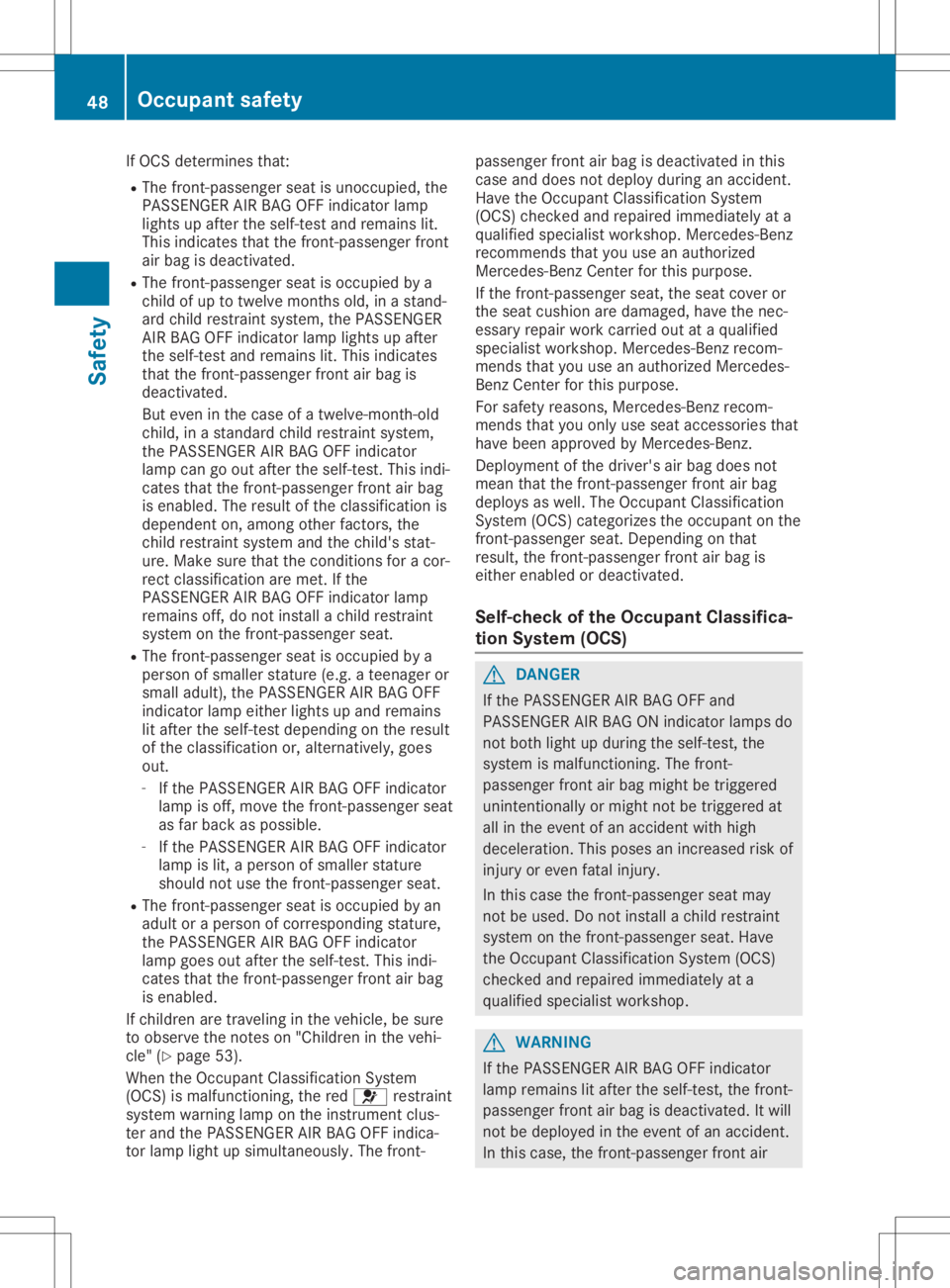
If
OCS determines that:
R The front-passenger seatisunoccupi ed,the
PASSENGER AIRBAG OFFindicator lamp
lights upafter theself-test andremains lit.
This indicates thatthefront-passenger front
air bag isdeactiva ted.
R The front-passenger seatisoccupie dbya
child ofup totwelve months old,inas tand-
ard child restraint system,thePASSENGER
AIR BAG OFFindicator lamplights upafter
the self-test andremains lit.This indicates
that thefront-passenger frontairbag is
deactiva ted.
But even inthe case ofat welve-month-old
child, inas tandard childrestraint system,
the PASSENGER AIRBAG OFFindicator
lamp cangoout after theself-test. Thisindi-
cates thatthefront-passenger frontairbag
is enabled. Theresul tofthe classi fication is
depende nton, among otherfactors, the
child restraint systemandthechild's stat-
ure. Make surethattheconditions foracor-
rect classi fication aremet. Ifthe
PASSENGER AIRBAG OFFindicator lamp
remains off,donot install achild restraint
system onthe front-passenger seat.
R The front-passenger seatisoccupie dbya
person ofsmall erstature (e.g.ateenager or
small adult),the PASSENGER AIRBAG OFF
indicator lampeither lightsupand remains
lit after theself-test dependingon the resul t
of the classi fication or,alternativel y,goes
out.
- Ifthe PASSENGER AIRBAG OFFindicator
lamp isoff, move thefront-passenger seat
as far back aspossib le.
- Ifthe PASSENGER AIRBAG OFFindicator
lamp islit, aperson ofsmall erstature
shoul dnotuse thefront-passenger seat.
R The front-passenger seatisoccupie dbyan
adu ltor ap erson ofcorresponding stature,
the PASSENGER AIRBAG OFFindicator
lamp goesoutafter theself-test. Thisindi-
cates thatthefront-passenger frontairbag
is enable d.
If childre naretraveling inthe vehicle ,bes ure
to observe thenotes on"Ch ildre nint he vehi-
cle" (Ypage 53).
When theOccupant Classifica tionSystem
(OCS) ismalfu nctioning, thered 0075 restraint
system warning lamponthe instrument clus-
ter and thePASSENGER AIRBAG OFFindica-
tor lamp lightupsimul taneousl y.The front- passe
ngerfront airbag isdeactiva tedinthis
case anddoes notdepl oyduri nganaccident.
Have theOccupant Classifica tionSystem
(OCS) checked andrepai redimmedi atelyata
qua lifiedspecia listworkshop. Mercedes-Benz
recommends thatyouuseanauthori zed
Mercedes-Benz Centerforthis purpo se.
If the front-passenger seat,theseat cover or
the seat cushio naredama ged,have thenec-
essary repairwork carried outataq ualifie d
specia listworkshop. Mercedes-Benz recom-
mends thatyouuseanauthori zedMercedes-
Benz Center forthis purpo se.
For safety reasons, Mercedes-Benz recom-
mends thatyouonly useseat accessorie sthat
have been appro vedbyMercedes-Benz.
Deploy mentofthe driver's airbag does not
mean thatthefront-passenger frontairbag
depl oysaswell .The Occupant Classifica tion
System (OCS)categorizes theoccupant onthe
front-passenger seat.Depending onthat
resul t,the front-passenger frontairbag is
either enabledordeactiva ted.
Self-c heckofthe Occupant Classifica-
tion System (OCS) G
DA
NGER
If the PASSENGER AIRBAG OFFand
PASSENGER AIRBAG ONindicator lampsdo
not both lightupd uring the self-test, the
system ismalfu nctioning. Thefront-
passe ngerfront airbag might betriggered
unintentionally ormight notbetriggered at
all inthe event ofan accident withhigh
decele ration. Thisposes anincreased riskof
injury oreven fatalinjury.
In this case thefront-passenger seatmay
not beused .Don otinstall achild restraint
system onthe front-passenger seat.Have
the Occupant Classifica tionSystem (OCS)
checked andrepai redimmedi atelyata
qua lifiedspecia listworkshop. G
WARNING
If the PASSENGER AIRBAG OFFindicator
lamp remains litafter theself-test, thefront-
passe ngerfront airbag isdeactiva ted.Itwil l
not bedepl oyed inthe event ofan accident.
In this case, thefront-passenger frontair 48
Occ
upant safetySafety
Page 51 of 310

bag
cann otperfor mitsint ended protective
func tion,e.g. when aperson isseated inthe
fron t-passenger seat.
That person could,forexample, comeinto
con tact with thevehicle's interior, especially
if the person issitt ing too close tothe dash-
board. Thisposes anincr eased riskofinjury
or even fatalinjury.
When thefron t-passenger seatisocc upied,
always ensure that:
R the classific ationofthe person inthe
fron t-passenger seatiscorr ectand the
fron t-passenger frontairbag isenabled or
deactiv atedinaccor dance withtheper-
son inthe fron t-passenger seat
R the person isseated properly withacor-
rect lyfasten edseatbelt
R the fron t-passenger seathasbeen moved
as far back aspossible
If the PAS SENGER AIRBAGO FFindicat or
lamp remains litwhen itshould not,the
fron t-passenger seatmust notbeused. Do
not installac hild restraint system onthe
fron t-passenger seat.Have theOcc upant
Classification System(OCS)checkedand
repaired immediately ataq ualified specialist
worksh op. G
WARN
ING
Objec tsbetween theseat surface andthe
child restraint system couldaffect OCS operation
.This could result inthe fron t-
passenger airbag notfunc tioningasinten-
ded during anacciden t.This poses an
incr eased riskofinjury oreven fatalinjury.
Do not place anyobjec tsbetween theseat
surface andthechild restraint system. The
ent irebase ofthe child restraint system
must always restonthe seat cushion ofthe
fron t-passenger seat.Thebackr estofthe
forward- facingchild restraint system must,
as far aspossible, berest ingonthe back-
rest ofthe fron t-passenger seat.Always
comply withthechild restraint system man-
ufactur er'sinstallation instruct ions.
Aft erthe self-t est,thePAS SENGER AIRBAG
OFF orthe PAS SENGER AIRBAGO Nindicat or
lamp displays thestatusofthe fron t-
passenger frontairbag (Ypage 46).Ifthe
fron t-passenger frontairbag isenabled, the
PAS SENGER AIRBAGO Nindicat orlamp lights
up for 60secon dsand then goes out.
If the PAS SENGER AIRBAGO Nindicat orlamp
is off, only thePAS SENGER AIRBAGO FFindi-
cator lampshows thestatusofthe fron t-
passenger frontairbag. ThePASSENGER AIR
BA GO FFindicat orlamp maybelitcon tinu-
ously orbe off.
For more information abouttheOCS, see
"Problems withtheOcc upant Classification
System "(Ypage 49).
Problems withtheOccupant Classification System(OCS) Be
sure toobserve thenoteson "System self-test"(Ypage 48). Occupant
safety
49Safet y Z
Page 52 of 310
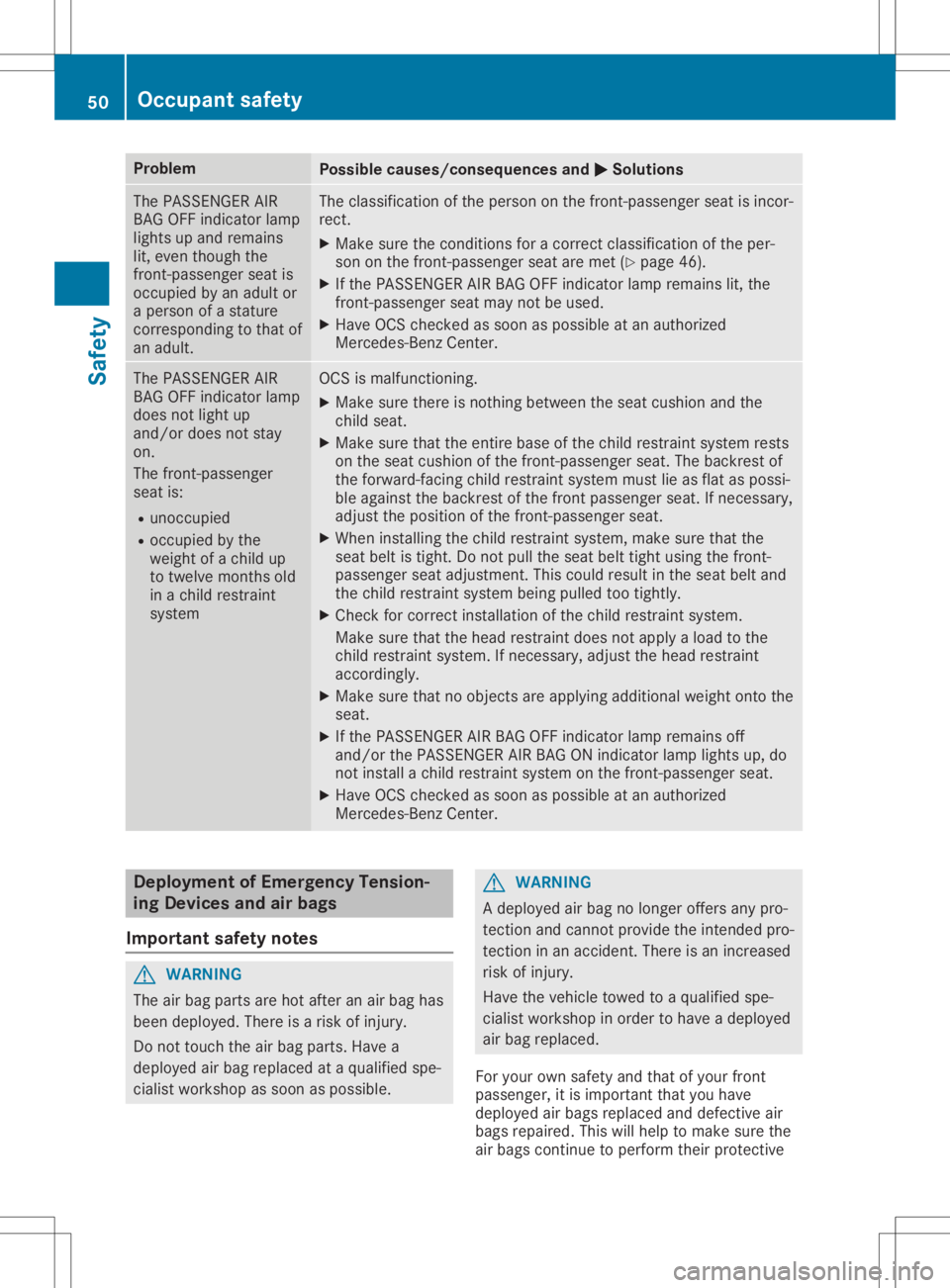
Problem
Possible
causes/co nsequences and0050 0050
Solutions The
PASS ENGER AIR
BAG OFFindicator lamp
lights upand remains
lit, even though the
front -passenger seatis
occupied byan adult or
ap erson ofas tature
correspondin gtot hat of
an adult. The
classification ofthe person onthe front -passenger seatisincor-
rect.
X Make surethecondition sfor ac orrect classification ofthe per-
son onthe front -passenger seataremet (Ypage 46).
X Ifthe PASS ENGER AIRBAG OFFindicator lampremains lit,the
front -passenger seatmaynotbeused.
X Have OCScheck edassoon aspossible atan authorized
Mercedes-Ben zCenter. The
PASS ENGER AIR
BAG OFFindicator lamp
does notlight up
and/or doesnotstay
on.
The front -passenger
seat is:
R unoccupied
R occupied bythe
weight ofac hild up
to twelve monthsold
in ac hild restraint
system OCS
ismalfunctionin g.
X Make surethere isnothin gbetween theseat cushion andthe
child seat.
X Make surethattheentire baseofthe child restraint systemrests
on the seat cushion ofthe front -passenger seat.Thebackrest of
the forward-facing childrestraint systemmustlieasflat aspossi-
ble against thebackrest ofthe front passenger seat.Ifnecessary,
adjust theposition ofthe front -passenger seat.
X When installing thechild restraint system,makesurethatthe
seat beltistight. Donot pull theseat belttight using thefront -
passenger seatadjustment .This could result inthe seat beltand
the child restraint systembeingpulled tootightly.
X Check forcorrect installation ofthe child restraint system.
Make surethatthehead restraint doesnotapply aload tothe
child restraint system.Ifnecessary, adjustthehead restraint
accordingly.
X Make surethatnoobject sareapply ingadditional weightontothe
seat.
X Ifthe PASS ENGER AIRBAG OFFindicator lampremains off
and/or thePASS ENGER AIRBAG ONindicator lamplights up,do
not install achild restraint systemonthe front -passenger seat.
X Have OCScheck edassoon aspossible atan authorized
Mercedes-Ben zCenter. Deployment
ofEmergency Tension-
ing Devic esand airbags
Import antsafety notes G
WARNING
The airbag parts arehot after anair bag has
been deploye d.There isar isk ofinjury.
Do not touch theairbag parts. Havea
deploye dairbag replaced ataq uali fied spe-
cialist workshop assoon aspossible. G
WARNING
Ad eploye dairbag nolonger offersanypro-
tect ionand cannot provide theinten dedpro-
tect ioninan accident. Thereisan increased
risk ofinjury.
Have thevehicle towedtoaq uali fied spe-
cialist workshop inorder tohave adeploye d
air bag replaced.
For your ownsafety andthat ofyour front
passenger, itis important thatyouhave
deploye dairbags replaced anddefective air
bags repaired. Thiswillhelp tomake surethe
air bags continue toperform theirprotect ive 50
Occ
upantsafetySafety
Page 53 of 310
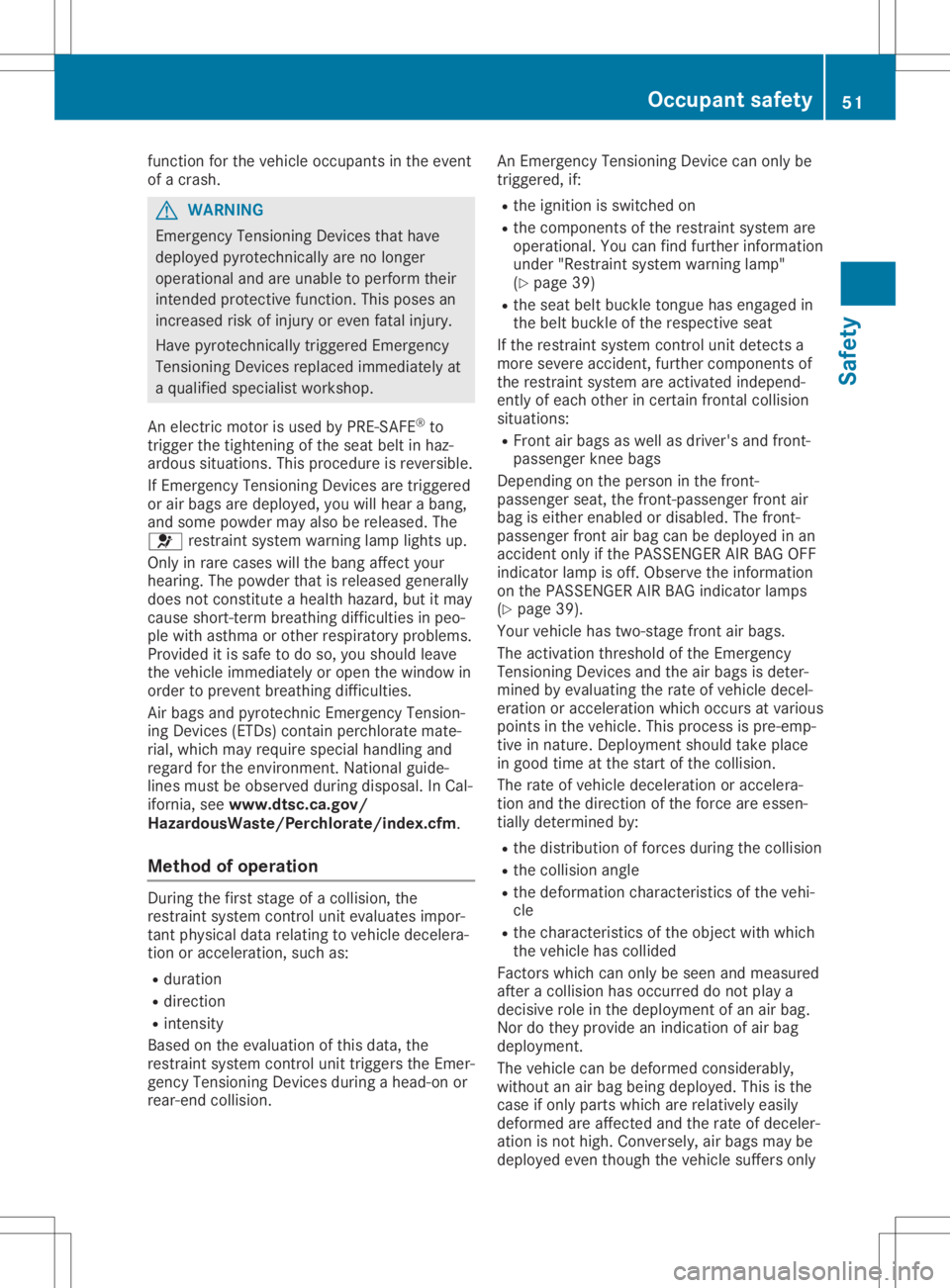
function
forthe vehicl eoccupa ntsinthe event
of ac rash. G
WARNING
Emergency TensioningDevices thathave
depl oyedpyro technical lyare nolonge r
opera tional andareunab leto perform their
intended protective function.Thispose san
increas edrisk ofinjury oreven fatalinjury .
Have pyrotechnical lytrigger edEmergency
Tensio ningDevices replaced immed iatelyat
aq ualified speci alist worksho p.
An electric motor isuse dbyPRE-SAFE ®
to
trigger thetightening ofthe seatbelti nh az-
ardo ussitua tions. Thisproced ureisreversi ble.
If Emergency TensioningDevices aretrigger ed
or air bag saredepl oyed,you willhearab ang,
and some powdermay alsob erele ase d.The
0075 restrai ntsystem warning lamplights up.
Only inrare cases willthe bang affect your
hea ring. Thepowderthat isrele asedgenera lly
does notconstitute ahealth haza rd,but itmay
caus eshort-term breathing difficulti esinpeo-
ple with asthma orother respiratory problems.
Provid editis safe todo so, you shou ldlea ve
the vehicl eimmed iatelyor open thewind owin
order toprevent breathing difficulti es.
Air bag sand pyro technic Emergency Tension-
ing Devices (ETDs)contain perchloratemate-
rial ,which may requirespeci alhandl ingand
rega rdfor the environment. Nationalguide-
lines must beobse rved duringdisp osal.InC al-
ifornia ,see ww w.dtsc.c a.gov/
HazardousWaste/ Perchlorate/i ndex.cfm.
Method ofoperatio n During
thefirst stage ofac ollision, the
restrai ntsystem controlunitevaluates impo r-
tant physical datarelating tovehicl edecel era-
tion oraccele ration, suchas:
R dura tion
R dire ction
R intensity
Based onthe eval uation ofthis data ,the
restrai ntsystem controlunittrigger sthe Emer-
gency TensioningDevices duringahead-on or
rear-end collision. An
Emergency TensioningDevice canonly be
trigger ed,if:
R the igniti onisswi tched on
R the components ofthe restrai ntsystem are
opera tional.You can find further informa tion
under "Restrai ntsystem warning lamp"
(Y pag e39)
R the seatbeltb uckle tongue hasengag edin
the beltbuckle ofthe respe ctiveseat
If the restrai ntsyste mcontrol unitdetects a
more severe accident,further components of
the restrai ntsyste mareactiva tedindep end-
ently ofeach other incertain frontalcollision
situa tions:
R Front airbag sasw ella sd rive r'sand front-
pas senger kneebags
Dependi ngon the perso nint he front-
pas senger seat,the front-passe ngerfront air
bag iseither enabledordisa bled.The front-
pas senger frontairbag canbedepl oyedina n
accid entonly ifthe PASSENGER AIRBAG OFF
indica torlam piso ff.Obser vethe informa tion
on the PASSENGER AIRBAG indica torlam ps
(Y pag e39).
You rvehicl ehastwo-stage frontairbag s.
The activa tionthreshol dofthe Emergency
Tensio ningDevices andtheairbag sisd eter-
mined byeval uating therate ofvehicl edecel -
erati onoraccele rationwhichoccurs atvari ous
poi nts inthe vehicl e.This process ispre-emp -
tive innature. Deployment shouldtake place
in good timeatthe start ofthe colli sion.
The rate ofvehicl edecel erati onoraccele ra-
tion andthedirection ofthe force areessen-
tial lydetermi nedby:
R the distri butionofforces duringthe colli sion
R the colli sion angle
R the deforma tionchara cteristics ofthe vehi-
cle
R the chara cteristics ofthe object withwhich
the vehicl ehascolli ded
Factors whichcan only beseen andmeas ured
after acollision hasoccurred donot playa
decis iverole inthe depl oyme ntofan air bag .
Nor dothey provi deanindica tionofair bag
depl oyme nt.
The vehicl ecan be deforme dconside rably,
witho utan air bag being depl oyed.This isthe
case ifonly parts whichare relatively easily
deforme dareaffected andtherate ofdecel er-
ation isnot high .Convers ely,airbag smaybe
depl oyedeven though thevehicl esuffe rsonly Oc
cupant safety
51Safety Z
Page 54 of 310
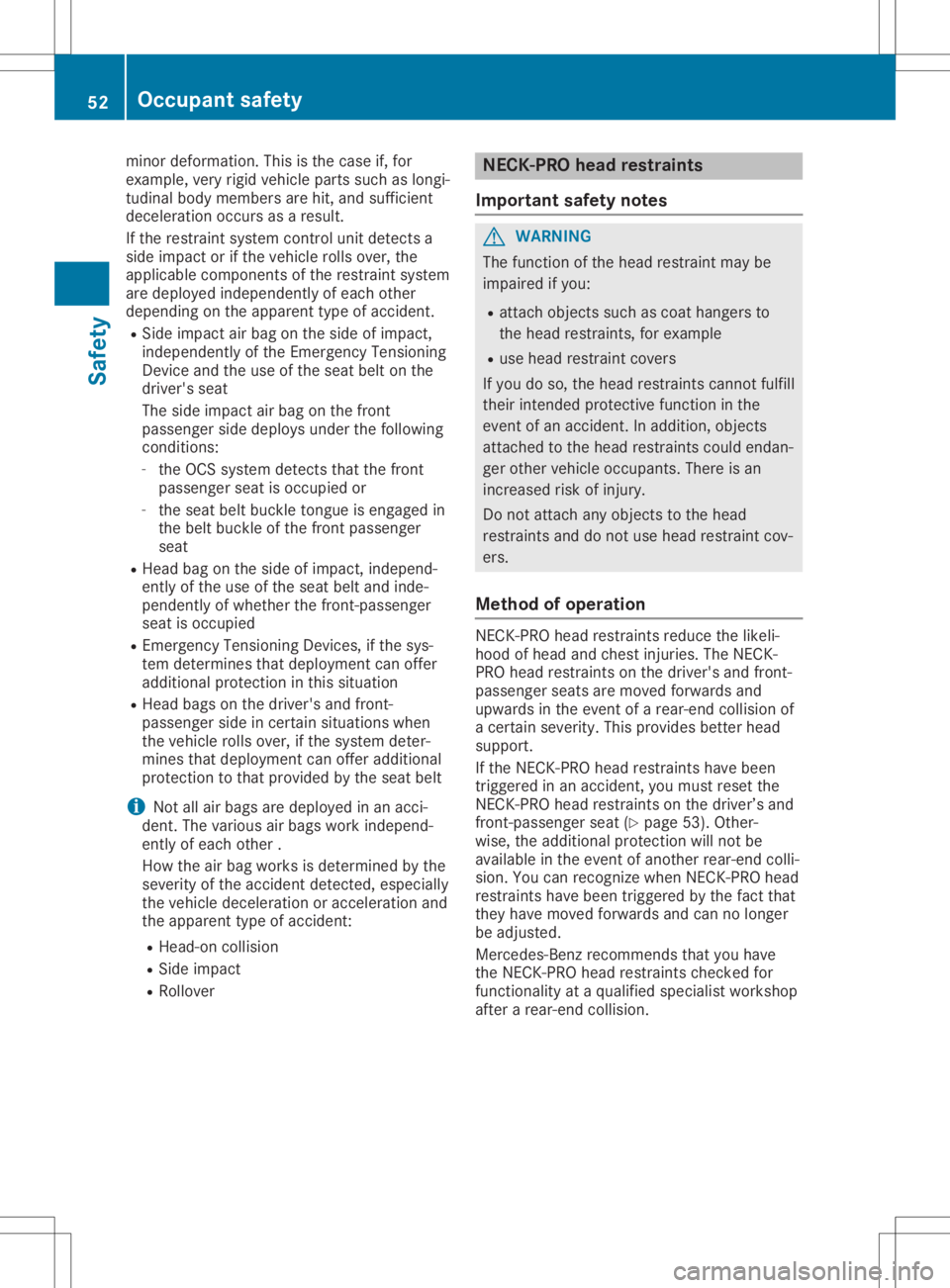
minor
deforma tion.Thisisthe case if,for
exampl e,very rigid vehicl eparts such aslongi-
tudina lbody members arehit,and suffici ent
decel eratio noccurs asaresul t.
If the restraint systemcontrolunitdetects a
side impa ctor ifthe vehicl erolls over, the
app licable components ofthe restraint system
are depl oyedindepe ndently ofeach other
depe nding onthe apparent typeofaccide nt.
R Side impactair bag onthe side ofimpa ct,
indepe ndently ofthe Emergency Tensioning
Device andtheuse ofthe seat beltonthe
driver' sseat
The side impa ctair bag onthe front
pass enger sidedeploysunder thefollo wing
conditions:
- the OCS system detects thatthefront
pass enger seatisoccupi edor
- the seat beltbuckle tongue isengage din
the belt buckle ofthe front passenger
seat
R Head bagonthe side ofimpa ct,indepe nd-
ently ofthe use ofthe seat beltandinde-
pendently ofwhether thefront-passenger
seat isoccupi ed
R Emergency TensioningDevices, ifthe sys-
tem determines thatdeployme ntcan offer
add itional protection inthis situa tion
R Head bagsonthe driver' sand front-
pass enger sideincertain situations when
the vehicl erolls over, ifthe system deter-
mines thatdeployme ntcan offer additional
protection tothat provid edbythe seat belt
i Not
allair bags aredepl oyedina na cci-
dent. Thevario usair bags work indepe nd-
ently ofeach other .
How theairbag works isdetermined bythe
severi tyof the accide ntdetected, especially
the vehicl edecel eratio noraccele ration and
the apparent typeofaccide nt:
R Head-on collision
R Side impact
R Rol lover NECK
-PROhead restraints
Important safetynotes G
WARNING
The function ofthe head restraint maybe
impa iredifyou :
R attach objects suchascoat hangers to
the head restraints, forexampl e
R use head restraint covers
If you doso, the head restraints cannotfulfill
their intended protective functioninthe
event ofan accide nt.Inadd ition, objects
attached tothe head restraints couldendan-
ger other vehicleoccupa nts.There isan
increase drisk ofinjury.
Do not attach anyobjects tothe head
restraints anddonot use head restraint cov-
ers.
Method ofoperation NECK-PRO
headrestraints reducethe likel i-
hood ofhead andchest injurie s.The NECK-
PRO head restraints onthe driver' sand front-
pass enger seatsaremoved forwardsand
upw ards inthe event ofar ear-end collision of
ac ertain severity.This provid esbetter head
supp ort.
If the NECK-PRO headrestraints havebeen
triggere dina na ccide nt,you must reset the
NECK-PRO headrestraints onthe driver’ sand
front-passenger seat(Ypage 53).Other-
wise ,the add itional protection willnot be
avai lablein the event ofanother rear-end colli-
sion. Youcanrecognize whenNECK-PRO head
restraints havebeen triggered bythe fact that
they have moved forwardsand cannolonger
be adju sted.
Mercede s-Benzrecommends thatyouhave
the NECK-PRO headrestraints checkedfor
functionali tyat aq ualified specia listworkshop
after arear-end collision. 52
Occ
upant safetySafety
Page 58 of 310
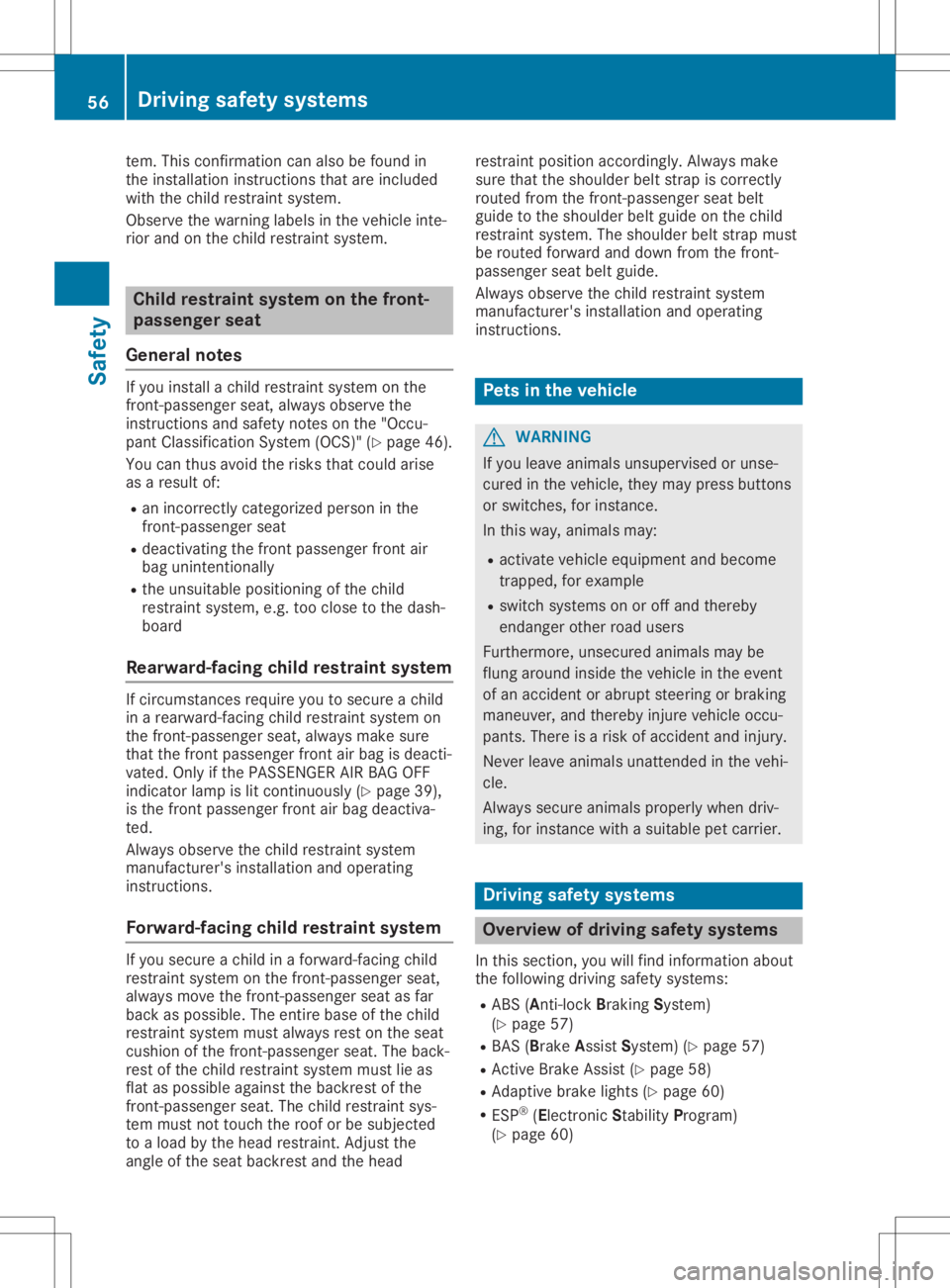
tem.
Thisconfi rma tionc an also be fou ndin
the installatio ninstru ctio nstha tare incl uded
wi th the childres traint syste m.
Ob serve the warning labe lsin the vehiclei nte -
rio ra nd onthe childres traint syste m. Ch
ildr estrain tsystem onthe front-
pass engers eat
Ge neral notes If
yo ui nstal lac hild res traint syste mo nthe
fro nt-pa ssenge rseat,alwa ysobserve the
ins tructio nsand safety note sonthe "Occu -
pa nt Clas sific ati on Sys tem (OCS) "(Y pa ge 46) .
Yo uc an thu savoid the risks tha tcouldarise
as aresulto f:
R an inco rrectly cate gorized perso nint he
fro nt-pa ssenge rseat
R de acti vating thefrontpasse nge rfront air
ba gu nintenti onally
R the unsuitab lepo sitio ning ofthe child
res traint syste m, e.g.too closetothe dash-
bo ard
Rea rwa rd-fac ingc hild res train tsystem If
cir cum stances require yout os ecureac hild
in ar earw ard-fa cing childres traint syste mo n
the front-pa ssenge rseat,alwa ysma kesure
tha tthe frontpasse nge rfront airb ag isde acti -
va ted .Onlyi fthe PASSEN GERAIRBAG OFF
ind icator lamp islitc onti nuously(Y page 39),
is the frontpasse nge rfront airb ag deacti va-
ted .
Alw ayso bserve the childres traint syste m
ma nuf actu rer'sins tallatio na nd opera ting
ins tructio ns.
Fo rwa rd-fac ingc hild res train tsystem If
yo us ecureac hild inaf orwa rd-f acing child
res traint syste mo nthe front-pa ssenge rseat,
al wa ysmov ethe front-pa ssenge rseata sfar
ba ck aspossi ble. The entirebase ofthe child
res traint syste mm usta lway sr esto nt he seat
cus hion ofthe front-pa ssenge rseat.The back-
res tofthe childres traint syste mm ustlie as
fla ta sp ossibl ea gainst the backre stof the
fro nt-pa ssenge rseat.The childres traint sys-
tem mustnot touchthe rooforb es ubjected
to aloa db ythe head res traint. Adju stthe
ang leof the seat backre stand thehead res
traint positio na ccord ingly.A lway sm ake
su re tha tthe sho ulde rb elts tra pisc orr ectl y
rou ted fromt hefront-pa ssenge rseatb elt
gu idet ot he sho ulde rb eltg uide on the child
res traint syste m. Thes houlde rb elts tra pm ust
be rou ted forwa rdand down fromt hefront-
pa sse nge rseatb eltg uide .
Alw ayso bserve the childres traint syste m
ma nuf actu rer'sins tallatio na nd opera ting
ins tructio ns. Pe
ts inthe vehic le G
WA
RNING
If yo ul eave ani ma lsuns uperv ised oruns e-
cur edinthe vehicle, the ym aypre ssbuttons
or sw itch es,for ins tance .
In thi sw ay,a nima lsma y:
R acti vate veh iclee quipm ent and become
tra pped,for exa mpl e
R sw itch syste ms onoroff and thereb y
end angerothe rroa du sers
Fur thermo re,uns ecu red anima lsma ybe
flu ng arou nd insidet he veh iclei nt he eve nt
of an acc ident orabrupt ste ering orbra king
ma neu ver,and the reb yinju reveh icleo ccu -
pa nts. There isar isko faccident and injury.
Nev erleav ea nima lsuna ttend edinthe vehi-
cle .
Alw ayss ecurea nima lspro perly when driv-
ing ,for ins tance with as uita blep etcar rier. Dri
ving safety systems Ov
erv iewo fdriv ings afety systems
In thi ss ectio n,youw illf indi nform ation abou t
the followi ng drivin gs afety syste ms:
R ABS (Anti -lock Bra king Sys tem)
(Y page 57)
R BAS (Bra keAss istS ys tem) (Ypage 57)
R Activ eBrake Assi st(Y page 58)
R Ada ptive bra kelights (Ypage 60)
R ESP ®
(Ele ctroni cSta bility Pro gram)
(Y page 60) 56
Dr
ivi ng safet ys ystemsSa fet y
Page 194 of 310
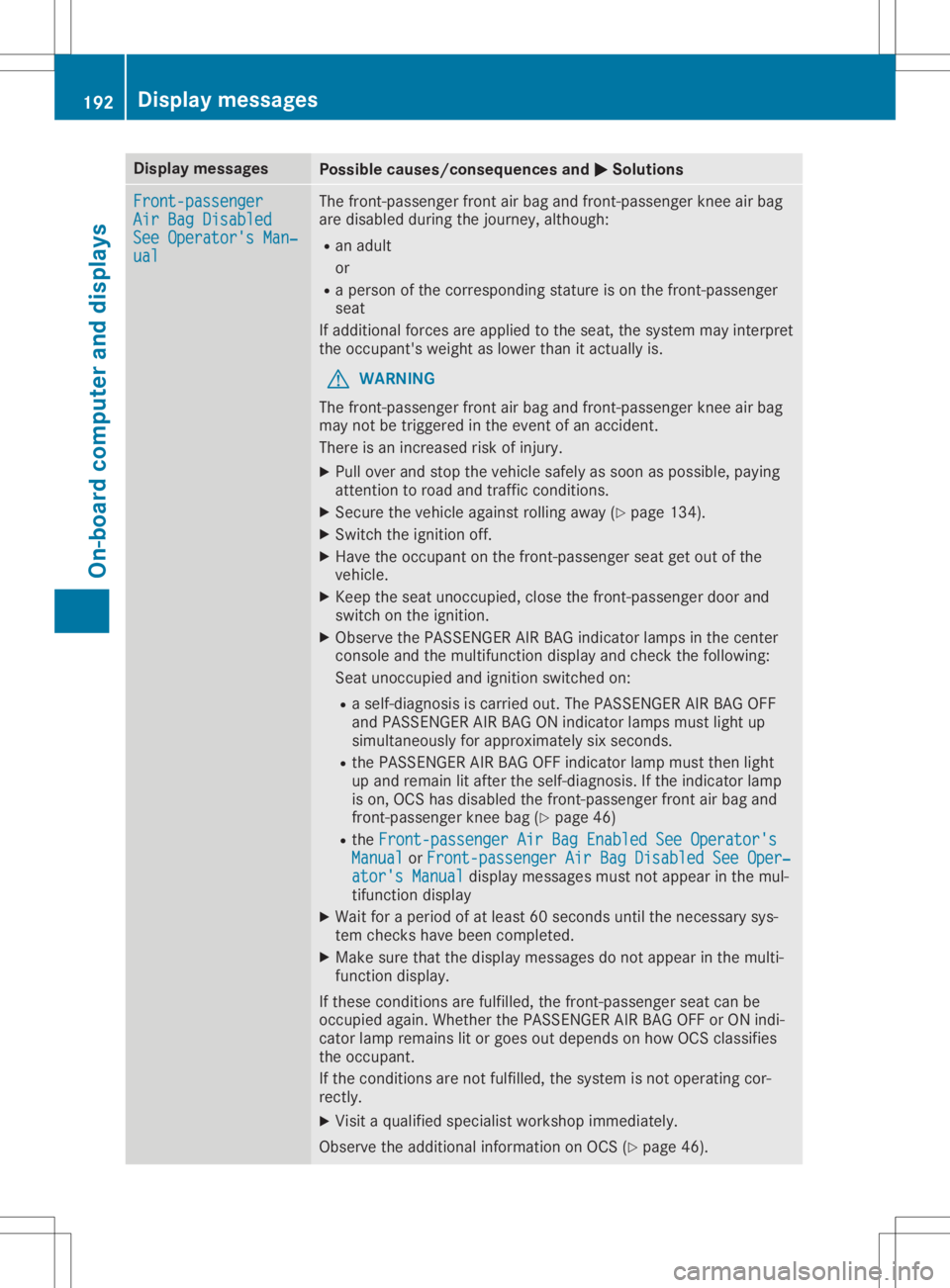
Disp
laymes sages Poss
iblecauses/co nsequences and 0050 0050
Solu tions Fro
nt-passenger Fro
nt-passenger
Air BagDisabled Air
BagDisabled
See Operator'sM an‐ See
Operator'sM an‐
ual ual The
fron t-pass enger fron ta irbag and fron t-pass enger knee air bag
are disab ledduri ngthej ou rney, althoug h:
R an adult
or
R ap erson ofthec orresp on din gstatur eiso nthe fron t-pass enger
seat
If addit ionalfor cesa reapplie dtothe seat ,the syst emmay interp ret
th eo ccup ant 'sweigh taslower than itact ually is.
G WAR
NING
The fron t-pass enger fron ta irbag and fron t-pass enger knee air bag
may notb etrigge red inthee vent ofan acc iden t.
The reisan increas edrisko finjury.
X Pull overand stop thev ehicles afely assoo naspossibl e,payin g
att ention toroa dand traff icco nd ition s.
X Se cur ethe veh iclea gain strol linga way (Ypage 134).
X Swi tcht he ignition off.
X Hav ethe occup ant onthef ront-pa ssen ger seat getout ofthe
veh icle.
X Kee pthe seat unoccupied ,close thef ront-pa ssen ger door and
swit chon thei gn ition .
X Obs ervethe PASS EN GER AIRB AG indicat orlamp sint he center
co nsole and them ultifun ction disp layand checkt he followin g:
Se at uno ccupied andignition swit ched on:
R as elf-diagn osis iscar riedo ut.T he PASS EN GER AIRB AG OFF
and PASS EN GER AIRB AG ON indicat orlamp smustligh tup
sim ultane ousl yfor appr oximat elysixsec onds.
R theP ASSENG ERAIRB AG OFFind icat orlamp mustthe nligh t
up and remainlitaft erthes elf-diagn osis.Ift he indicat orlamp
is on ,O CS has disab ledthef ront-pa ssen ger fron ta irbag and
fr on t-pass enger knee bag (Ypage 46)
R theFro nt-passenger AirBagEnabledS eeOpe rator's Fro
nt-passenger AirBagEnabledS eeOpe rator's
Man ual Man
ual orFro nt-passenger AirBagDisabledSee Oper‐ Fro
nt-passenger AirBagDisabledSee Oper‐
ato r's Manual ato
r's Manual displaymes sage smustn otappear inthem ul-
ti fun ction disp lay
X Wait foraperiod ofat least 60sec onds unt ilth en ecessar ysys-
te mc hecksh aveb een compl eted.
X Mak esuret hatthe disp laymes sage sdon otappear inthem ulti-
fun ction disp lay.
If th ese cond ition sarefulf illed ,the fron t-pass enger seat canbe
oc cup iedagain .Whether theP ASSENG ERAIRB AG OFFo rONindi-
cat orlamp remainslitor goe soutdepe ndso nh ow OCS classifies
th eo ccup ant .
If th ec ondition sa renotfulf illed ,the syst emisno to per ating cor-
rec tly.
X Vis itaq ualif iedspecialistwor kshop immediat ely.
Obs ervethe addit ionalinf orm ation onOCS (Ypage 46). 192
Disp
laymes sage sOn -boar dcomp uter andd ispla ys